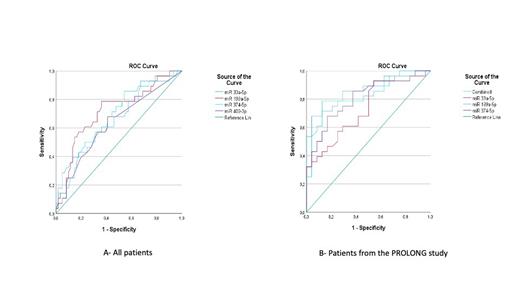Introduction
Currently, there is no specific diagnostic test for immune thrombocytopenia (ITP). MicroRNAs (miRNA) are small, noncoding RNAs involved in the post-transcriptional regulation of gene expression. Aberrant expression of miRNAs has been suggested to have potential diagnostic value. Previous explorative studies have identified several differentially expressed miRNAs in ITP with potential diagnostic value; however, such findings are usually difficult to reproduce. Therefore, we aimed to validate some of these miRNAs in a larger ITP cohort.
Methods
Based on previous studies in ITP, we selected 12 miRNAs for validation in patients with primary ITP. The following miRNA were selected: miR-199a-5p, miR-33a-5p, miR-195-5p, miR-130a-3p, miR-144-3p, miR-146a-5p, miR-222-3p, miR-374-5p, miR-486-5p, miR-1341-5p, miR-766-3p, miR-409-3p. Blood samples (n=61) were obtained from 2 cohorts of primary ITP and healthy controls. The first cohort included samples from 24 patients with newly diagnosed or persistent ITP from the PROLONG study (NCT00344149); all patients had been treated with corticosteroids +/- IVIG but relapsed or failed to respond. The second cohort included 37 samples obtained from the ITP biobank at Østfold Hospital, Norway; patients had different disease phases and had received different therapies. In addition, 28 samples were obtained from healthy controls.
The miRNAs were quantified in citrated plasma using droplet digital PCR (Bio-Rad).
Results
The mean age of the ITP patients was 51 years (62% female) and of the controls 47 years (64% female). The mean platelet count for all patients was 48.8 ·10 9/L. PROLONG patients had a lower mean platelet count (33 ·10 9/L) than patients from ITP biobank (59 ·10 9/L).
Mann-Whitney test showed that miR-199a-5p (p=0.001), miR-33a-5p (p=0.010), miR-374-5p (p=0.009) and miR-146a-5p (p=0.026) were significantly differentially expressed (downregulated) in ITP compared with controls. Subgroup analysis of PROLONG patients showed that 3 additional miRNAs (7 of the 12 miRNAs) were significantly differentially expressed (downregulated) in these ITP patients: miR-130a-3p (p=0.005), miR-766-3p (p=0.010) and miR-409-3p (p=0.001).
ROC curve analysis showed good discrimination for miR-199a-5p in all patients with an AUC of 0.718 (95% CI 0.599-0.836), and satisfactory for miR-33a-5p with an AUC of 0.671 (CI 0.549-0.793), 0.673 (CI 0.554-0.792) for miR-374-5p and 0.632 (CI 0.505-0.759) for miR-409-3p (Figure A).
Subgroup analysis for each of the two cohorts separately showed higher AUC in PROLONG patients for miR-199a-5p (AUC=0.824; 95% CI 0.708-0.940), miR-374-5p (AUC=0.806; 95% CI 0.688-0.924), and for miR-33a-5p (AUC=0.732; 95% CI 0.597-0.868). The combination of all three miRNAs: miR-199a-5p, miR-33a-5p and miR-374-5p in PROLONG patients resulted in a slight improvement of the AUC to 0.865 (CI 0.767-0.962) (Figure B).
Conclusions
This study confirms that miR-199a-5p, miR-33a-5p, miR-374-5p and miR-146a-5p are differentially expressed in primary ITP compared with healthy controls. miR-199a-5p shows a good ability to discriminate primary ITP patients from healthy controls. In the PROLONG cohort, both miR-199a-5p and miR-374-5p showed a very good discrimination, probably due to the fact that these patients had early ITP. These findings should be further validated in a prospective cohort of newly diagnosed ITP patients and in patients with other types of thrombocytopenia to explore their potential diagnostic value. Some of these miRNAs have important regulatory functions, particularly in inflammation and apoptosis, so it is essential to evaluate their function and role in the pathogenesis of ITP and their potential use as therapeutic targets.
Disclosures
Garabet:Grifols: Honoraria. Ghanima:Bayer: Consultancy, Honoraria, Research Funding; Sanofi: Consultancy, Honoraria; BMS: Honoraria, Research Funding; Argenx: Consultancy, Honoraria; Grifols: Consultancy, Honoraria; hibio: Consultancy, Honoraria; Novartis: Consultancy, Honoraria; cellphire: Consultancy, Honoraria; alpine: Consultancy, Honoraria; Sobi, Pfizer: Consultancy, Honoraria, Research Funding; Amgen: Consultancy, Honoraria; Kedrion: Consultancy; UCB: Consultancy, Honoraria.


This feature is available to Subscribers Only
Sign In or Create an Account Close Modal